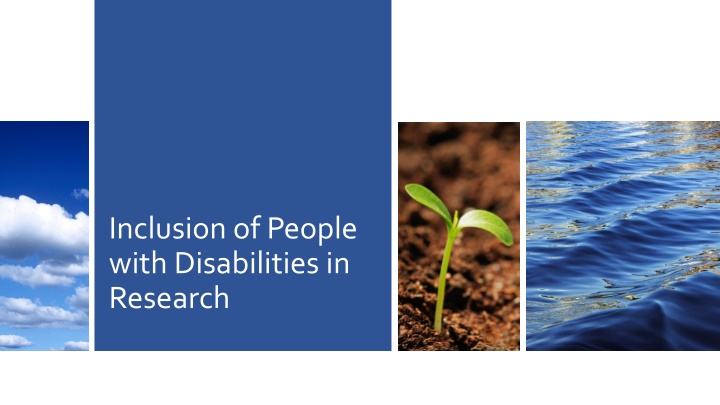
Ableism, Bias, and Effects in Research and Development
Explore the concepts of ableism, bias, and their effects on research and development processes. Learn about the inclusion of people with disabilities, implicit bias, institutionalized bias, and the disparities they create in education, health, transportation, employment, and research. Discover key steps in the instrument development process and how accessibility impacts the validity of research outcomes.
Download Presentation

Please find below an Image/Link to download the presentation.
The content on the website is provided AS IS for your information and personal use only. It may not be sold, licensed, or shared on other websites without obtaining consent from the author. If you encounter any issues during the download, it is possible that the publisher has removed the file from their server.
You are allowed to download the files provided on this website for personal or commercial use, subject to the condition that they are used lawfully. All files are the property of their respective owners.
The content on the website is provided AS IS for your information and personal use only. It may not be sold, licensed, or shared on other websites without obtaining consent from the author.
E N D
Presentation Transcript
Inclusion of People with Disabilities in Research
Ableism ideas, practices, institutions, and social relations that presume able bodiedness, and by so doing, construct persons with disabilities as marginalized and largely invisible others (Chouinard 1997, p. 380) prejudice and discrimination toward individuals simply because they are classified as disabled regardless of whether their impairments are physical or mental, visible or invisible. (Nario Redmond, 2020, p. 6)
Bias Implicit bias Positive or negative attitudes or stereotypes that affect our understanding, actions, and decisions in an unconscious manner. Institutionalized bias A tendency for the procedures and practices of particular institutions to operate in ways which result in certain social groups being advantaged or favoured and others being disadvantaged or devalued. This need not be the result of any conscious prejudice or discrimination but rather of the majority simply following existing rules or norms. Institutional racism and institutional sexism are the most common examples. (Oxford Reference)
Effects of ableism Disparities Education Health Transportation Employment AND Research!
This slide is designed to show key steps in process instrument development, use and interpretation process. 1. Content experts design a test and then work with IT experts to make those abstract measures real and computer administrable. Accessibility and research? Measurement 2. Then participants get the information/test stimuli from the computer. The presentation format within the Toolbox is typically visual or auditory. Measurement Expert 3. They then process the information. X 4. And input their response. In the Toolbox this is often done by activating the mouse or the keyboard. 5. Finally, the expert (clinical or research) gets what they assume is a valid and interpretable score. X 6. If there is a mismatch between the way the information is presented and the way the individual can access information, there is a problem. 7. When that happens, the information provided back to the researcher is invalid.
Example: Picture Vocabulary Description: This computer adaptive test measures receptive vocabulary. Task demands AUDITORY: High. Participant must be able to hear words presented orally by a recorded voice. VISUAL: High. Participant must be able to see and differentiate 4 photographic images of varying complexity. COGNITIVE: High. Participant must be able to understand the word or concept and have sufficient abstraction to associate the word with the photographic image. MOTOR: Moderate. Participant must be able to use a mouse or alternate input device to target an image on screen (size approximately, 2 x 3 )
Accessibility and research cont. Physical access
Accessibility Accessibility is giving equitable access to everyone along the continuum of human ability and experience. Accessibility encompasses the broader meanings of compliance and refers to how organizations make space for the characteristics that each person brings.
Why consider accessibility in health research? Large numbers of people with disabilities within the United States, People with disabilities live with a thinner margin of health and disability overlaps with chronic conditions, Federal policy encourages inclusion of people with disabilities and federal laws provide legal protections for people with disabilities, Inclusion of people with disabilities increases the utility of health research to support clinical decision making, social service allocation and policy, Equal access is the ethical approach.
Why consider accessibility in health research cont? Accessibility barriers affect the conduct of science. Sampling bias Researchers can find it easier to use arguments of expediency or distorted canons of rigor to ignore or to exclude persons with disabilities (Meyers & Andresen, p. S5) Validity, meaningfulness, and interpretability Fairness is a fundamental validity issue and a test cannot be valid if some aspect of it differentially advantages one group of people over another (AERA, p. 49).
What is accessible research design? Accessibility as social justice and a communal responsibility Collective Access The spirit of the law going beyond requirements Universal Design Civil rights/legal accessibility Accommodations
Accessibility Considerations in Research Recruitment Consent Facility access Transportation Measurement Interventions
Accessibility & Standardization Tension between accessibility and standardization Accessibility (accommodation, modification, universal design) Standardization
Conclusion When people with disabilities are systematically excluded because of inaccessible measurement systems, interventions, and research practices, health research findings are not representative of the population and not useful in decision-making. Accessibility requires a commitment by researchers to consider the different bodies and minds most likely to occur in a sample and plan ways to ensure inclusion of all people including those with disabilities
